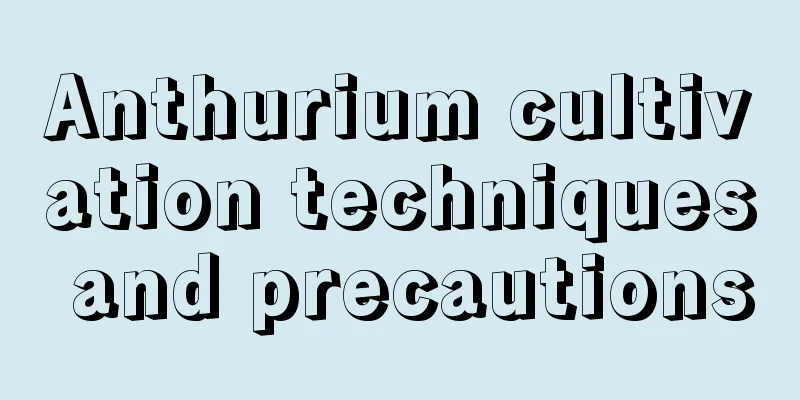Anthurium cultivation techniques and precautions

|
Anthurium, with its thick green leaves and emerald green texture, unique flower shape and flame-like bright red flowers, is an ornamental plant that is appreciated for both its flowers and leaves. It is deeply loved by the public and is an ideal potted plant. In order to make the anthurium thrive and bloom a pot full of "flame flowers", let's learn some cultivation techniques and precautions for anthurium below. 1. Breeding techniques 1. Lighting management Anthurium prefers a semi-shady environment and cannot withstand strong direct sunlight, otherwise the leaves will easily be burned and appear scorched and yellow. But it cannot be placed in a corner that is too dark, otherwise it will cause the plant to grow poorly and the flower color to fade. It is recommended to place the anthurium near an indoor window or under a shade awning with bright diffuse light. In summer, you need to use a shade net to block 50%-70% of the sunlight, while in winter you can increase the lighting time appropriately. 2. Temperature Control Anthurium is native to tropical regions and the suitable growth temperature is 18℃-28℃. When the temperature is below 10℃, the growth of the plant will be inhibited and the leaves may suffer frost damage; when the temperature is above 35℃, the growth rate will slow down and the flowers will tend to age and wither prematurely. Anthuriums need to be moved to a warm place indoors in winter, and can be cooled in summer through ventilation, spraying water, etc. 3. Watering tips Anthurium likes a humid environment, but cannot tolerate stagnant water. When watering, you should follow the principle of "water when dry and water when wet", that is, wait until the soil surface is slightly dry before watering. The amount of water should be enough to wet the soil but not accumulate water. In summer, watering is required every day, and water can be sprayed on the leaves appropriately to increase the air humidity; in winter, watering is required every 7-10 days. 4. Fertilization method During the vigorous growth period of Anthurium, apply thin liquid fertilizer every 1-2 weeks. You can choose a compound fertilizer with a balanced nitrogen, phosphorus and potassium. Before flowering, increase the application of phosphorus and potassium fertilizers, such as potassium dihydrogen phosphate solution, to promote flower bud differentiation and flower development. When applying fertilizer, avoid direct contact between fertilizer and roots and leaves, and stop fertilizing in winter. 5. Soil selection Anthurium is suitable for loose, breathable, well-drained soil rich in organic matter. You can mix peat soil, perlite and coconut bran in a ratio of 3:1:1, and add a small amount of decomposed organic fertilizer , such as cake fertilizer or bone meal. 2. Precautions 1. Avoid stagnant water The root system of anthurium is not well developed, and stagnant water can easily lead to root rot. When watering, you need to control the amount of water to ensure good soil permeability. 2. Prevent and control pests and diseases Anthurium is susceptible to diseases such as anthracnose and leaf spot, as well as pests such as red spider mites and scale insects. When pests and diseases are found, the diseased leaves should be removed in time and treated with fungicides or insecticides . Maintain good ventilation and avoid plants growing too densely. 3. Maintain ventilation Anthurium requires a well-ventilated environment, especially in summer and winter, to avoid the breeding of pests and diseases due to lack of ventilation. 4. Change the pot at the right time Anthurium generally needs to be repotted every 2-3 years, and the best time is spring and autumn. When repotting, you can trim the old roots and add new acidic substrate. In summary, Anthurium is a flower with extremely high ornamental value, and is deeply loved by people for its gorgeous flowers and unique flower shape. The above are the cultivation techniques and precautions for Anthurium. With proper maintenance, you can take better care of the Anthurium, making its leaves green and its flowers lush.
|
<<: Gardenia cultivation tips and precautions
>>: Cultivation techniques and precautions for daffodils
Recommend
What to do if the Clerodendrum thomsoniae blooms less? Finding the reason is the key!
Causes and treatment methods If you want to know ...
Cultivation methods and precautions of hollyhock
How to grow hollyhock illumination Hollyhock pref...
Anthurium cultivation method
1. Loose soil Soil with a looser texture is more ...
What are the breeding methods and precautions of Panax notoginseng?
Panax notoginseng breeding method Panax notoginse...
When does cosmos bloom?
1. Factors affecting flowering ① Nutrients: If th...
How to plant carnation seeds: How to germinate, do you need to soak them in water?
1. Planting method 1. Seeds: First, you need to b...
How to prune lilies
When to prune lilies When caring for lilies, if y...
How to prune Osmanthus fragrans (pruning time and method)
When to prune the osmanthus Osmanthus fragrans is...
What crops are suitable for growing in wetlands?
What crops are suitable for growing in wetlands? ...
Can expired beer be used to water flowers directly? What is the use?
Use expired beer to water flowers Expired beer ca...
Is the green radish suitable for a deep or shallow pot?
Should I use a deep or shallow pot for my green r...
What are the varieties of plumeria?
Plumeria rubra This is an introduced species, nat...
How to plant copper coin grass? Planting time and method
Planting time of copper coin grass The cultivatio...
How to prune figs in spring
1. How to trim 1. The pruning time is generally a...
Planting and management of forsythia trees, when to fertilize
1. Planting method 1. Site selection and land pre...









